Conneaut Lake, Pennsylvania
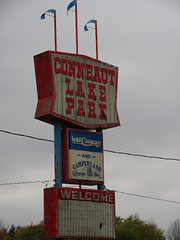 This weekend excursion seemed to have death as a unifying theme. It started with death-in-itself by visiting the isolated ruins of Geauga Lake, which now exists in a state of utter nihilation of which ‘living on in our memories’ are of little compensation. Then we moved on to two thriving parks in the midst of their Halloween festivals; this is death transformed into kitsch by the living as objects of fascination and fear. And now we would finish with a place that’s epitomized by a precarious existence in close proximity to death: Conneaut Lake Park. Especially on a cold, rainy autumnal day like today, it was difficult to sustain the illusion that everyone gathered at this place was innocently here for merriment and celebration. Everyone, from visitors to employees, was keenly aware of how much of a struggle it was for the 120 year old park to stay operational for even an additional week, and we had better enjoy what’s left of it while we still can. There was a sense that our patronage was similar to visiting an old friend dying in the hospital, where we’d do our best to laugh and talk optimistically about the chances of a full recovery, even though no one’s willing to admit that we appear to be in the presence of a ghost.
This weekend excursion seemed to have death as a unifying theme. It started with death-in-itself by visiting the isolated ruins of Geauga Lake, which now exists in a state of utter nihilation of which ‘living on in our memories’ are of little compensation. Then we moved on to two thriving parks in the midst of their Halloween festivals; this is death transformed into kitsch by the living as objects of fascination and fear. And now we would finish with a place that’s epitomized by a precarious existence in close proximity to death: Conneaut Lake Park. Especially on a cold, rainy autumnal day like today, it was difficult to sustain the illusion that everyone gathered at this place was innocently here for merriment and celebration. Everyone, from visitors to employees, was keenly aware of how much of a struggle it was for the 120 year old park to stay operational for even an additional week, and we had better enjoy what’s left of it while we still can. There was a sense that our patronage was similar to visiting an old friend dying in the hospital, where we’d do our best to laugh and talk optimistically about the chances of a full recovery, even though no one’s willing to admit that we appear to be in the presence of a ghost.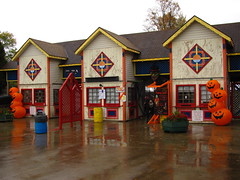
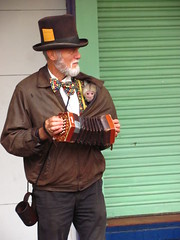 Paint is peeling, metal is rusting, and dirt and water are creeping into the microscopic crevices of every surface. People huddle beneath a few creaky verandas and tents to protect themselves from the rain; even the organ grinder’s monkey seeks protection from the cold in the warm pocket of his master. All of this is ephemeral: a particular state of existence that will slowly
Paint is peeling, metal is rusting, and dirt and water are creeping into the microscopic crevices of every surface. People huddle beneath a few creaky verandas and tents to protect themselves from the rain; even the organ grinder’s monkey seeks protection from the cold in the warm pocket of his master. All of this is ephemeral: a particular state of existence that will slowly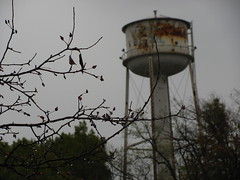 but inevitably unravel before sundown, part of a grand process of annihilation that steadily replaces one state of entropy with that of another. Conneaut Lake Park is either on a rapid path towards the wrecking ball, or towards a massive, community-led resurrection, and although it’s still uncertain which of these directions it will go, what remains certain is that the park we visited today cannot remain static. Time, whether it results in the good or the bad, is intrinsically linked to transformation, entropy, and death, and time at Conneaut Lake is a very limited, precious resource.
but inevitably unravel before sundown, part of a grand process of annihilation that steadily replaces one state of entropy with that of another. Conneaut Lake Park is either on a rapid path towards the wrecking ball, or towards a massive, community-led resurrection, and although it’s still uncertain which of these directions it will go, what remains certain is that the park we visited today cannot remain static. Time, whether it results in the good or the bad, is intrinsically linked to transformation, entropy, and death, and time at Conneaut Lake is a very limited, precious resource.
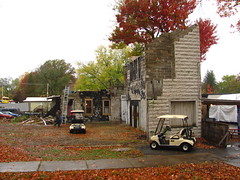 It was a minor miracle that the park was open at all this weekend. Over the past decade it has been subject to corrupt management, total insolvency, neglect, theft, and multiple arsons. When the ninety-nine year old Dreamland Ballroom burned to the ground in February 2008 (the result of a community with troubled youths with no other outlets) almost everyone figured that was the final coup de grâce of the grassroots effort to get the park reopened after it sat dormant for the entire 2007 season due to insufficient funds. If there was only one silver lining to the whole situation, it was that Conneaut Lake made a pretty dramatic backdrop for the apocalyptic drama The Road, which filmed there shortly after the fire.
It was a minor miracle that the park was open at all this weekend. Over the past decade it has been subject to corrupt management, total insolvency, neglect, theft, and multiple arsons. When the ninety-nine year old Dreamland Ballroom burned to the ground in February 2008 (the result of a community with troubled youths with no other outlets) almost everyone figured that was the final coup de grâce of the grassroots effort to get the park reopened after it sat dormant for the entire 2007 season due to insufficient funds. If there was only one silver lining to the whole situation, it was that Conneaut Lake made a pretty dramatic backdrop for the apocalyptic drama The Road, which filmed there shortly after the fire.
Yet, somehow, the Trustees of Conneaut Lake Park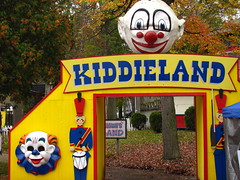 managed to assemble a plan that would get the needed reparations work done to the remaining rides and structures, so that the business would once again see income flow. After opening a few of the rides in 2009 (some belonging to the park, others brought in by outside carnival vendors), a fundraiser selling gold tokens, and then a Pepsi Refresh Grant,1 allowed them to hire Leonard Adam’s Structural Technologies Inc. to do a refurbishment of the signature Blue Streak coaster that would allow it to run once more in late 2010. One year later the work on the Blue Streak is still ongoing, with most of the track replaced on the far turnaround while the rest of the hills and drops still run with the old, potholed track, but we weren’t going to let its incompleteness stop us from making a stop on the way back home from eastern Pennsylvania. Conneaut Lake
managed to assemble a plan that would get the needed reparations work done to the remaining rides and structures, so that the business would once again see income flow. After opening a few of the rides in 2009 (some belonging to the park, others brought in by outside carnival vendors), a fundraiser selling gold tokens, and then a Pepsi Refresh Grant,1 allowed them to hire Leonard Adam’s Structural Technologies Inc. to do a refurbishment of the signature Blue Streak coaster that would allow it to run once more in late 2010. One year later the work on the Blue Streak is still ongoing, with most of the track replaced on the far turnaround while the rest of the hills and drops still run with the old, potholed track, but we weren’t going to let its incompleteness stop us from making a stop on the way back home from eastern Pennsylvania. Conneaut Lake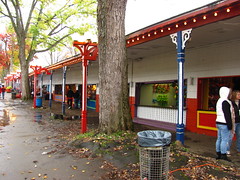 is still in dire financial peril, only one more alienated arsonist away from total dereliction, and putting off visiting for one more season could be a very risky gamble indeed. Besides, even if the weather was awful and the coaster running far from top form, I wanted to spend my money here as a show of solidarity. The trustees don’t have much cash to work with, but they do at least have a local community that wanted Conneaut Lake and was willing to do what they could to support it; without the continuation of that will, there would be absolutely no hope for the park’s future.
is still in dire financial peril, only one more alienated arsonist away from total dereliction, and putting off visiting for one more season could be a very risky gamble indeed. Besides, even if the weather was awful and the coaster running far from top form, I wanted to spend my money here as a show of solidarity. The trustees don’t have much cash to work with, but they do at least have a local community that wanted Conneaut Lake and was willing to do what they could to support it; without the continuation of that will, there would be absolutely no hope for the park’s future.
The result is akin to a reanimated zombie of an amusement park, functional but not really alive.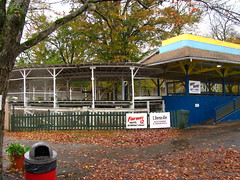 With every penny needing to be spent just to get the place open there’s virtually no cash left over for any cosmetic improvements. While some international coaster travelers might delight in finding a park that’s conspicuously lacking the clean, sterile presentation typical of most amusement parks, the sad truth is this isn’t just an apocalyptic wasteland movie set theme park, but the hard reality for large parts of rural
With every penny needing to be spent just to get the place open there’s virtually no cash left over for any cosmetic improvements. While some international coaster travelers might delight in finding a park that’s conspicuously lacking the clean, sterile presentation typical of most amusement parks, the sad truth is this isn’t just an apocalyptic wasteland movie set theme park, but the hard reality for large parts of rural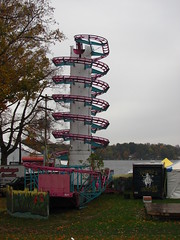
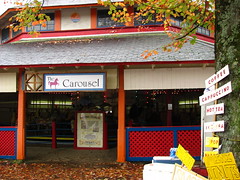 America. The funds needed to revitalize Conneaut Lake Park into the beautiful lakeside park it once was and still has potential to be would probably be a drop in the ocean if it was managed by any of the big corporate players in the amusement industry, but just keeping the midways clear of debris or dismantling broken rides are luxuries that Conneaut Lake Park can’t necessarily afford.
America. The funds needed to revitalize Conneaut Lake Park into the beautiful lakeside park it once was and still has potential to be would probably be a drop in the ocean if it was managed by any of the big corporate players in the amusement industry, but just keeping the midways clear of debris or dismantling broken rides are luxuries that Conneaut Lake Park can’t necessarily afford.
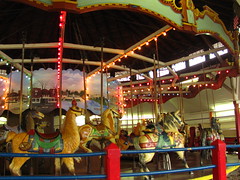 Nevertheless, even in its current downtrodden state there’s still a lot that will genuinely appeal to fans of classic amusement
Nevertheless, even in its current downtrodden state there’s still a lot that will genuinely appeal to fans of classic amusement parks making it well worth their while to visit even if they’re not interested in visiting the park out of charity. One of the most notable flat rides is the Harry Traver built Tumble Bug dating back to 1925, one of only two full sized models left in the world (although the other one is only a
parks making it well worth their while to visit even if they’re not interested in visiting the park out of charity. One of the most notable flat rides is the Harry Traver built Tumble Bug dating back to 1925, one of only two full sized models left in the world (although the other one is only a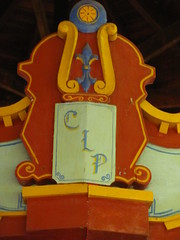 short drive away at Pittsburgh’s Kennywood Park, and I think a third might still be oxidizing out in the woods of the former Chippewa Lake Park). The Tumble Bug was not open for my visit. This is not the oldest ride in the park, as their Allan Herschell Bessemer Railway is a few years older, and the antique Carousel (built by D.C. Muller and T.M. Harton) turned 100 years old in 2010. Despite the grandiose pavilion it resides in the carousel itself is somewhat small and quaint, but it does have a pleasing hand-made quality to it, including an oil-painted mural of Conneaut Lake mounted around the center hub. Judging by the noise it was making, the band organ was an original piece of equipment as well. While I appreciate that they haven’t replaced it with an electronic speaker system, the music had gotten so humorously out of tune that my dad had flashbacks of his time as a conductor for elementary school bands.
short drive away at Pittsburgh’s Kennywood Park, and I think a third might still be oxidizing out in the woods of the former Chippewa Lake Park). The Tumble Bug was not open for my visit. This is not the oldest ride in the park, as their Allan Herschell Bessemer Railway is a few years older, and the antique Carousel (built by D.C. Muller and T.M. Harton) turned 100 years old in 2010. Despite the grandiose pavilion it resides in the carousel itself is somewhat small and quaint, but it does have a pleasing hand-made quality to it, including an oil-painted mural of Conneaut Lake mounted around the center hub. Judging by the noise it was making, the band organ was an original piece of equipment as well. While I appreciate that they haven’t replaced it with an electronic speaker system, the music had gotten so humorously out of tune that my dad had flashbacks of his time as a conductor for elementary school bands.
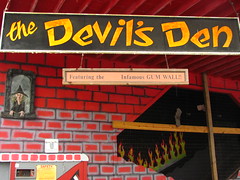 The Devil’s Den dark ride is one of the more unique pleasures to be found at Conneaut Lake Park. This is a gravity-driven dark ride built by Pretzel Manufacturing in 1968, “featuring the Infamous GUM WALL!!” as the sign out front proudly states. I know some people consider this to be a roller coaster, due to the presence of a chain lift hill at the beginning that is followed by a gravity driven track featuring one relatively large drop and rise followed by a set of wild mouse style switchbacks in the dark. I’m not sure if I’m sold on this label, if only because I’d still classify it as a dark ride first. Of course it matters not what we call it, but how much fun it is. Aside from the gum wall at the top of the lift, the Devil’s Den is a bit light on ‘gotcha’ scares and eerie decorative set pieces, as the first part of the layout is on display for the midway to watch while
The Devil’s Den dark ride is one of the more unique pleasures to be found at Conneaut Lake Park. This is a gravity-driven dark ride built by Pretzel Manufacturing in 1968, “featuring the Infamous GUM WALL!!” as the sign out front proudly states. I know some people consider this to be a roller coaster, due to the presence of a chain lift hill at the beginning that is followed by a gravity driven track featuring one relatively large drop and rise followed by a set of wild mouse style switchbacks in the dark. I’m not sure if I’m sold on this label, if only because I’d still classify it as a dark ride first. Of course it matters not what we call it, but how much fun it is. Aside from the gum wall at the top of the lift, the Devil’s Den is a bit light on ‘gotcha’ scares and eerie decorative set pieces, as the first part of the layout is on display for the midway to watch while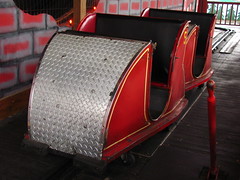 the second part is enclosed in a total darkness. However, it makes up for it because the gravity-driven track design becomes much more than just an alternative means of powering the vehicles through the course. Especially in the indoor section we take the turns just a little bit faster than feels customary for these types of classic dark rides, and absent the motorized hum pushing us through the course it takes on a strangely supernatural quality, as if some invisible spirit is guiding our way down into the valley of darkness against our wills. The resulting sensation is subtly yet distinctly unnerving, an experience that might not objectively be the best dark ride, but is certainly very memorable and a new personal favorite.
the second part is enclosed in a total darkness. However, it makes up for it because the gravity-driven track design becomes much more than just an alternative means of powering the vehicles through the course. Especially in the indoor section we take the turns just a little bit faster than feels customary for these types of classic dark rides, and absent the motorized hum pushing us through the course it takes on a strangely supernatural quality, as if some invisible spirit is guiding our way down into the valley of darkness against our wills. The resulting sensation is subtly yet distinctly unnerving, an experience that might not objectively be the best dark ride, but is certainly very memorable and a new personal favorite.
Yet as cool as the Devil’s Den is, the big draw of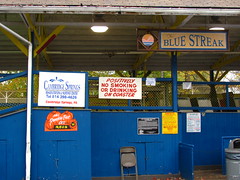 Conneaut Lake Park continues to be the Blue Streak. This 1938-built roller coaster is one of only two Edward Vettel designs remaining in the world, the other being the beautiful Lakeside Park Cyclone in Denver Colorado. I’ll admit that while I’m a sucker for all classic wooden coasters, I have a particular affinity for Vettel’s work, perhaps second only to the creations of Prior and Church (most of which I’ll never get a chance to ride). The Cyclone is one of the original genre
Conneaut Lake Park continues to be the Blue Streak. This 1938-built roller coaster is one of only two Edward Vettel designs remaining in the world, the other being the beautiful Lakeside Park Cyclone in Denver Colorado. I’ll admit that while I’m a sucker for all classic wooden coasters, I have a particular affinity for Vettel’s work, perhaps second only to the creations of Prior and Church (most of which I’ll never get a chance to ride). The Cyclone is one of the original genre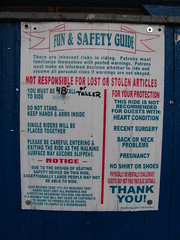 bending wooden coasters, starting off as a curvaceous, rough and tumble twister, and then halfway through transitioning into an easy going out-and-back set alongside the lake. Additionally, Vettel’s
bending wooden coasters, starting off as a curvaceous, rough and tumble twister, and then halfway through transitioning into an easy going out-and-back set alongside the lake. Additionally, Vettel’s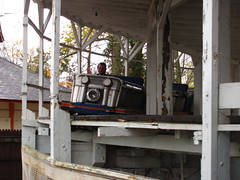 nephew Andy was responsible for the reimagining of the Kennywood Pippin into the Thunderbolt in 1968. Both are on my personal top ten list of favorite wooden coasters, for the combination of creative layouts with a unique, particular character that can’t be replicated in modern rides.
nephew Andy was responsible for the reimagining of the Kennywood Pippin into the Thunderbolt in 1968. Both are on my personal top ten list of favorite wooden coasters, for the combination of creative layouts with a unique, particular character that can’t be replicated in modern rides.
The Blue Streak lacks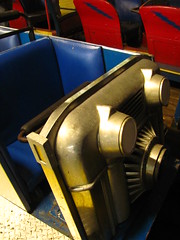 that same imaginative spark that makes the Lakeside Cyclone and
that same imaginative spark that makes the Lakeside Cyclone and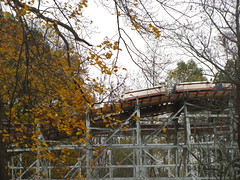 Kennywood Thunderbolt the all-time greats that they are, favoring a standard out-and-back configuration for the entire layout, but that’s hardly a criticism. Like the Lakeside Cyclone, it starts with a long, serpentine tunnel from the station to the lift hill. I wish more wooden coasters would start like this; they’re a terrific prelude and help make the overall experience feel more complete. The ride on the other side of the tunnel
Kennywood Thunderbolt the all-time greats that they are, favoring a standard out-and-back configuration for the entire layout, but that’s hardly a criticism. Like the Lakeside Cyclone, it starts with a long, serpentine tunnel from the station to the lift hill. I wish more wooden coasters would start like this; they’re a terrific prelude and help make the overall experience feel more complete. The ride on the other side of the tunnel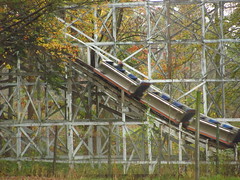 can feel very remote and rustic, almost entirely located beneath
can feel very remote and rustic, almost entirely located beneath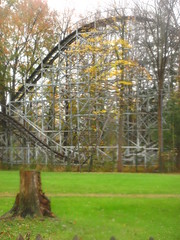 a dense canopy of mature trees that have grown up and over the peaks of even the Blue Streak’s biggest hills. I regret I didn’t have a chance to ride it after dark, as between the tunnel and the forested setting it must make a great night ride experience.
a dense canopy of mature trees that have grown up and over the peaks of even the Blue Streak’s biggest hills. I regret I didn’t have a chance to ride it after dark, as between the tunnel and the forested setting it must make a great night ride experience.
One other reason I’m particular to Ed Vettel’s designs are that the construction techniques he used are relatively unique in the world of wooden roller coasters. Most use John Miller’s track system, built with six to eight layers of vertically stacked wood on top of the ledgers and crossties, with the top layers
the construction techniques he used are relatively unique in the world of wooden roller coasters. Most use John Miller’s track system, built with six to eight layers of vertically stacked wood on top of the ledgers and crossties, with the top layers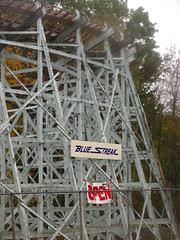 featuring an extended lip on the inside so the guide and upstop wheels can lock the car into place. Vettel’s track, however, has a couple layers of track bed set directly on top of the ledgers, then the crossties are set on top of this bed, and the rails consist of two additional layers of wood above the crossties with a steel L-beam bolted to the side that allows the guide wheels to double as the upstop wheels.2 Although it’s
featuring an extended lip on the inside so the guide and upstop wheels can lock the car into place. Vettel’s track, however, has a couple layers of track bed set directly on top of the ledgers, then the crossties are set on top of this bed, and the rails consist of two additional layers of wood above the crossties with a steel L-beam bolted to the side that allows the guide wheels to double as the upstop wheels.2 Although it’s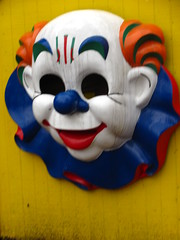 perhaps understandable why Miller’s design became the standard for future wooden coaster designers, separating the layers of stacked wood into a crosstie sandwich gives Vettel’s track a lighter ‘springboard’ feel to it, flexing with the train in a dynamic symbiotic relationship that can almost make it feel as if it’s alive. Visually, the thin topping layers also look much more fragile than they really are, and riding in the front row for the first time I had to question how this thing had managed to run even after so much neglect without a single derailment. They haven’t had a major incident yet so I guess I’ll trust that I’ll make it back to the station in one piece. The potholes on the bottom of some of the big drops can be a little rough (these sections had yet to be retracked by STI in 2011), but the cars bounce more than they jackhammer, and with the cushy NAD trains I found discomfort with the poor tracking to not be a major problem. The biggest issue at present is the trains lose too much speed to the poor trackwork, and on a cold October afternoon with mostly
perhaps understandable why Miller’s design became the standard for future wooden coaster designers, separating the layers of stacked wood into a crosstie sandwich gives Vettel’s track a lighter ‘springboard’ feel to it, flexing with the train in a dynamic symbiotic relationship that can almost make it feel as if it’s alive. Visually, the thin topping layers also look much more fragile than they really are, and riding in the front row for the first time I had to question how this thing had managed to run even after so much neglect without a single derailment. They haven’t had a major incident yet so I guess I’ll trust that I’ll make it back to the station in one piece. The potholes on the bottom of some of the big drops can be a little rough (these sections had yet to be retracked by STI in 2011), but the cars bounce more than they jackhammer, and with the cushy NAD trains I found discomfort with the poor tracking to not be a major problem. The biggest issue at present is the trains lose too much speed to the poor trackwork, and on a cold October afternoon with mostly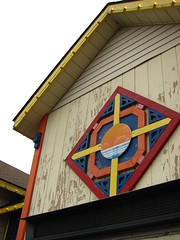 empty trains I occasionally had to wonder if we’d be able to clear all the hills. There’s not much airtime, although with just a bit more work that has the potential to change drastically in just a few seasons.
empty trains I occasionally had to wonder if we’d be able to clear all the hills. There’s not much airtime, although with just a bit more work that has the potential to change drastically in just a few seasons.
We ended up riding the Blue Streak more times than I initially planned on spending for tickets, but that was perfectly okay. I contemplated riding some other things in the park (kiddy coaster credit, maybe?) but the rain was coming down harder, we were at the end of an eventful but tiring weekend, and I had a philosophy paper due in a couple days that I needed to work on, so it was time to turn around and head home. I certainly plan to return to Conneaut Lake Park at the next opportunity, although exactly what the park will have d/evolved into by that time remains to be seen. Just as one cannot step in the same river twice, I daresay it’s impossible to ever visit the exact same Conneaut Lake Park twice.
Footnotes & Annotations
[1] This was one of the few times in recent memory that the coaster enthusiast community rallied together to help support a historic roller coaster. Granted, it required nothing more than to click a vote box online once a day for a month as Pepsi would be footing the entire bill, and even then it failed to get the votes needed on the first try. After their success in securing the $10,000 grant money the second time around, Conneaut Lake Park (and a few other “save the coaster/park/etc” campaigns) went back to the Pepsi Refresh well again looking to win some more cash, but these later attempts barely even registered a passing glance within the community. Probably it was just as well it ended that way, as surely there are more deserving charities in the world needing Pepsi’s money.
[2] Apparently this can produce a lot of sparks on the moments of negative g-forces, although it was too slow and too wet on my visit for the phenomena to be observable.
Did you get any back seat rides? I made a stop at the park last summer and, on the first three hills, found the most terrifying airtime I’ve ever experienced (followed by bruised knees as a result of rapid deceleration at the bottoms of said hills). The rest of the ride, however was extremely slow; there were only two other people in the train with me. There are only two rollercoasters on which I have involuntarily screamed: the Conneaut Lake Blue Streak and the Stricker’s Grove Tornado.
I rode in the back car twice, but it was too cold and empty to get anything like you’ve described. I’d like to try it again on a busier summer day sometime soon, as I’ve heard from several other sources as well that Blue Streak’s first few drops can be a pretty intense ride.
Did you ever revisit Conneaut Lake?
Nope, never got the chance to. Almost did a day trip to there and Waldameer in 2013, but plans got canceled at the last minute. Now I live in California so prospects aren’t good for the near future…